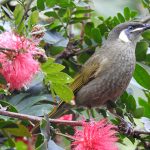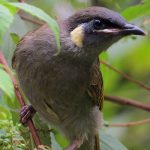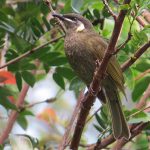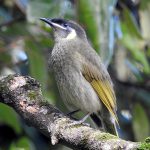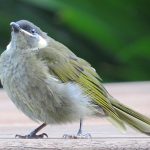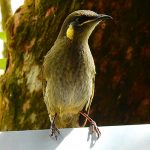LEWIN'S HONEYEATER
Lewin’s Honeyeater
The Lewin’s Honeyeater is a fascinating bird of Australia’s east coast, often heard before it is seen. With its lively calls and busy habits, it plays an important role in the forests it inhabits. Let’s explore its world.
Appearance
The Lewin’s Honeyeater is a medium-sized bird, about 20–24 cm long. Its plumage is mostly olive-green and dusky brown, blending well with the shadows of the rainforest. What makes it distinctive is a pale yellow crescent-shaped patch behind each eye, almost like a subtle flash of light when it turns its head. Its beak is long and slightly curved, perfectly shaped for sipping nectar from flowers.
Habitat and Range
This honeyeater is found along the eastern coast of Australia, stretching from northern Queensland down to central New South Wales. It thrives in:
- Rainforests
- Wet sclerophyll forests (tall eucalypt forests with dense understorey)
- Coastal scrub
If you wander through the cooler, damp gullies or the edges of lush rainforests, you are likely to hear its call echoing through the trees.
Behaviour and Diet
Lewin’s Honeyeaters are always on the move. Their diet reflects the life of a nectar-feeding bird, but with a twist:
- Nectar: They feed on blossoms of eucalypts, banksias, and other flowering plants.
- Insects and fruits: They also snatch insects mid-air or probe into foliage, and relish soft fruits, making them important seed dispersers.
Their call has been described as a sharp, repeated “machine-gun” like rattle – a sound that can carry far through the forest, often revealing their presence before they appear in sight.
Breeding and Nesting
Breeding usually takes place from July to January, when food sources are rich.
- Nest: A small cup made of plant fibres, moss, and spider webs, often hidden in dense foliage for safety.
- Eggs: Usually two, pale in colour with darker speckles.
- Parental care: Both parents share the responsibility of feeding the chicks, bringing a mix of insects and nectar to fuel their rapid growth.
Ecological Role
Lewin’s Honeyeaters are pollinators and seed dispersers, helping maintain the balance of forest ecosystems. Each time they dip their beak into a flower, they carry pollen from one bloom to another, ensuring plant reproduction. By eating fruits, they spread seeds across the forest floor, aiding regeneration.
Conservation Status
The species is currently listed as Least Concern, meaning it is not considered threatened. However, habitat loss from deforestation and urban expansion can impact local populations. Protecting rainforests and native vegetation is vital to keeping their numbers stable.
A Moment in the Forest
Imagine standing in a misty rainforest at dawn. The air is cool and scented with damp earth and eucalyptus. Suddenly, a sharp, rattling call cuts through the stillness. You scan the trees and catch a glimpse of olive-green feathers flitting between blossoms. The bird pauses, sunlight catching the yellow crescent behind its eye, before darting off again — a fleeting guardian of the forest, ensuring life continues through pollination and seed dispersal.
✨ The Lewin’s Honeyeater reminds us that even the smallest forest dwellers play a big part in keeping ecosystems alive. Protecting their homes means protecting the delicate web of life they sustain.

